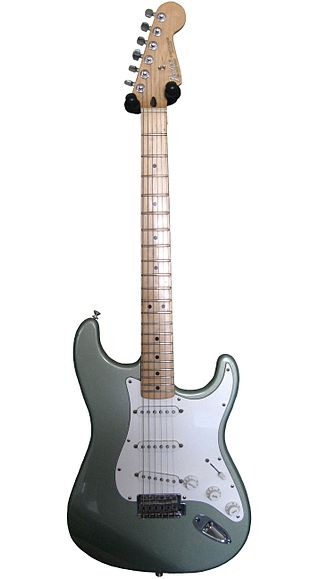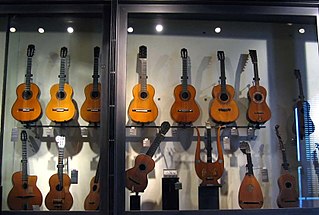
An electric guitar is a guitar that requires external amplification in order to be heard at typical performance volumes, unlike a standard acoustic guitar. It uses one or more pickups to convert the vibration of its strings into electrical signals, which ultimately are reproduced as sound by loudspeakers. The sound is sometimes shaped or electronically altered to achieve different timbres or tonal qualities from that of an acoustic guitar via amplifier settings or knobs on the guitar. Often, this is done through the use of effects such as reverb, distortion and "overdrive"; the latter is considered to be a key element of electric blues guitar music and jazz, rock and heavy-metal guitar-playing. Designs also exist combining attributes of the electric and acoustic guitars: the semi-acoustic and acoustic-electric guitars.

The guitar is a stringed musical instrument that is usually fretted and typically has six or twelve strings. It is usually held flat against the player's body and played by strumming or plucking the strings with the dominant hand, while simultaneously pressing selected strings against frets with the fingers of the opposite hand. A guitar pick may also be used to strike the strings. The sound of the guitar is projected either acoustically, by means of a resonant hollow chamber on the guitar, or amplified by an electronic pickup and an amplifier.

The Gibson SG is a solid-body electric guitar model introduced by Gibson in 1961, following on from the 1952 Gibson Les Paul. It remains in production today in many variations of the initial design. The SG Standard is Gibson's best-selling model of all time. SG stands for "solid guitar".

The Fender Stratocaster, colloquially known as the Strat, is a model of electric guitar designed between 1952 and 1954 by Leo Fender, Bill Carson, George Fullerton, and Freddie Tavares. The Fender Musical Instruments Corporation has continuously manufactured the Stratocaster since 1954. It is a double-cutaway guitar, with an extended top "horn" shape for balance. "Stratocaster" and "Strat" are trademark terms belonging to Fender. Guitars that duplicate the Stratocaster by other manufacturers are sometimes called S-Type or ST-type guitars. Many prominent rock musicians have been associated with the Stratocaster for use in studio recording and live performances, most notably Eric Clapton, Buddy Holly, David Gilmour, Mark Knopfler, Jimi Hendrix, Stevie Ray Vaughan, Mark Speer and George Harrison.

The Fender Jazzmaster is an electric guitar designed as a more expensive sibling of the Fender Stratocaster. First introduced at the 1958 NAMM Convention, it was initially marketed to jazz guitarists, but found favor among surf rock guitarists in the early 1960s. Its appearance is similar to the Fender Jaguar, though it is tonally and physically different in many technical ways, including pickup design, scale length and controls.
The Fender Jaguar is an electric guitar by Fender Musical Instruments characterized by an offset-waist body, a relatively unusual switching system with two separate circuits for lead and rhythm, and a short-scale 24" neck. Owing some roots to the Jazzmaster, it was introduced in 1962 as Fender's feature-laden top-of-the-line model, designed to lure players from Gibson. During its initial 13-year production run, the Jaguar did not sell as well as the less expensive Stratocaster and Telecaster, and achieved its most noticeable popularity in the surf music scene. After the Jaguar was taken out of production in 1975, vintage Jaguars became popular first with American punk rock players, and then more so during the alternative rock, shoegazing and indie rock movements of the 1980s and 1990s. Fender began making a version in Japan in the mid-1980s, and then introduced a USA-made reissue in 1999. Since then, Fender has made a variety of Jaguars in America, Mexico, Indonesia and China under both the Fender and Squier labels. Original vintage Jaguars sell for many times their original price.

The Fender Mustang is a solid body electric guitar produced by the Fender Musical Instruments Corporation. It was introduced in 1964 as the basis of a major redesign of Fender's student models, the Musicmaster and Duo-Sonic. It was produced until 1982 and reissued in 1990.

Godin Guitars is a Canadian manufacturing company headquartered in Montreal that specializes in string instruments. The company was founded by Robert Godin, and is currently led by Simon Godin.
The Jackson Soloist is an electric guitar model introduced by Jackson Guitars in 1984, although prototypes were available before then. The design is a typical "superstrat"; it varies from a typical Stratocaster because of its neck-thru design; tremolo: Floyd Rose or similar, Kahler; or a fixed Tune-O-Matic; premium woods; a deeper cutaway at the lower horn for better access to the higher frets, and a sharper body with squared-off edges.

The following outline is provided as an overview of and topical guide to guitars:
The Jackson Rhoads is a model of electric guitar, originally commissioned by guitarist Randy Rhoads and produced by Jackson Guitars.
An acoustic guitar is a musical instrument in the string family. When a string is plucked, its vibration is transmitted from the bridge, resonating throughout the top of the guitar. It is also transmitted to the side and back of the instrument, resonating through the air in the body, and producing sound from the sound hole. While the original, general term for this stringed instrument is guitar, the retronym 'acoustic guitar' – often used to indicate the steel stringed model – distinguishes it from an electric guitar, which relies on electronic amplification. Typically, a guitar's body is a sound box, of which the top side serves as a sound board that enhances the vibration sounds of the strings. In standard tuning the guitar's six strings are tuned (low to high) E2 A2 D3 G3 B3 E4.

Caparison Guitars is a Japanese-origin manufacturer of electric guitars. The company is headquartered in Japan and is a subsidiary of Caparison Guitar Company Ltd., based in the United Kingdom.

The Rickenbacker 330 is part of Rickenbacker's 300 series of guitars. The 330 entered the Rickenbacker product line in 1958, though at the time the 300 series of guitars was known as the "Capri" series. It was designed by the German luthier Roger Rossmeisl. The guitar is associated by many players with the jangle-rock sounds of bands from the 1960s and 1980s. The instrument incorporates many features standard on Rickenbacker guitars, including a three-ply maple/walnut neck, a shallow headstock angle, and a thick rosewood fretboard finished with clear conversion varnish. The 330 also features a body with Rickenbacker's "crescent moon" double-cutaway shape with sharp, unbound edges, and an R-shaped trapeze tailpiece. One idiosyncrasy of the guitar is its dual truss rods, which allow for the correction of problematic and unwanted twists, as well as curvature, of the guitar's neck. The 330 is equipped with a monaural jack plate, lacking the Rick-O-Sound stereo functionality of other Rickenbacker models such as the Rickenbacker 360.
Tacoma Guitars was an American manufacturing company of musical instruments. It was founded in 1991 as a division of South Korean company Young Chang. Instruments were manufactured in Tacoma, Washington. The company and brand name were later acquired by the Fender Musical Instruments Corporation. The Tacoma plant closed, and production ceased, in 2008.
Electric guitar design is a type of industrial design where the looks and efficiency of the shape as well as the acoustical aspects of the guitar are important factors. In the past many guitars have been designed with various odd shapes as well as very practical and convenient solutions to improve the usability of the object.

A stomp box is a percussion instrument consisting of a small box placed under the foot, which is tapped or stamped on rhythmically to produce a sound similar to that of a bass drum. A stomp box allows a performer such as a singer or guitar player to create a simple rhythmic self-accompaniment. Stompboxes are most commonly used in American folk and blues music, but they are also used across the musical spectrum.
The Rickenbacker 4001 is an electric bass that was manufactured by Rickenbacker as a two-pickup "deluxe" version of their first production bass, the single-pickup model 4000. This design, created by Roger Rossmeisl, was manufactured between 1961 and 1981, when it was replaced by an updated version dubbed the Rickenbacker 4003. Variant models of the 4001 include the 4001S, 4001LH, 1999, 4001V63 (reissue), 4001CS and the 4001C64 and 4001C64S: the C Series is a recreation of Paul McCartney's left-handed 4001S with a reversed headstock. There are also Al Cisneros and Lemmy Kilmister signature versions of the instrument.
Classical electric guitars, also known as nylon-string electric guitars, represent a unique fusion of traditional classical guitar design and modern electric guitar technology. These instruments combine the rich and warm tonal qualities of nylon-stringed classical guitars with the versatility and amplified sound capabilities of electric guitars. By integrating nylon strings with onboard electronics, pickups, and preamp systems, classical electric guitars offer musicians a wide range of sonic possibilities for various musical genres and performance settings.
The Fender Telecaster, colloquially known as the Tele, is an electric guitar produced by Fender. Together with its sister model the Esquire, it was the world's first mass-produced, commercially successful solid-body electric guitar. Its simple yet effective design and revolutionary sound broke ground and set trends in electric guitar manufacturing and popular music. Many prominent rock musicians have been associated with the Telecaster for use in studio recording and live performances, most notably Bruce Springsteen, Luis Alberto Spinetta, Keith Richards and George Harrison.


















